Paul Gauguin Biography
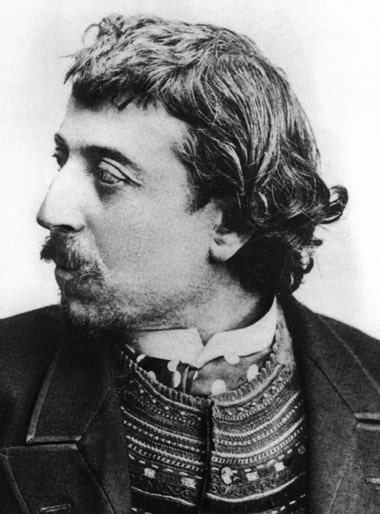
Paul Gauguin, a pioneering Post-Impressionist painter, is renowned for his colorful and primitivist style that defied artistic conventions of his time. His bold use of color and simplified forms set him apart as a visionary artist who pushed the boundaries of traditional art. Despite a tumultuous personal life, Gauguin's significant influence on modern art is undeniable, with his works resonating with audiences and inspiring generations of artists to explore new realms of creativity.
Early Life and Peruvian Influences
Paul Gauguin was born in Paris, France in 1848 to journalist Clovis Gauguin and Aline Maria Chazal, who had Peruvian heritage through her father. In 1850, when Gauguin was just two years old, the family fled the political unrest in France and moved to Peru. Tragically, Gauguin's father died on the voyage to Peru, leaving his mother, sister, and the young Paul to fend for themselves.
The family settled in Lima, Peru for four years, living with Gauguin's uncle. It was during this formative time in Peru that Gauguin was first exposed to the imagery and culture that would later influence his art. His mother admired Pre-Columbian pottery, collecting Inca pots that some colonists dismissed as barbaric. Gauguin also recalled his mother wearing the traditional costume of Lima, with one eye peeping out from behind the mysterious manteau veil worn by women in the city. These early experiences with "primitive" art and culture made a lasting impression on Gauguin and his future artistic sensibilities.
At the age of seven, Gauguin and his family returned to France, moving to Orléans to live with his grandfather. He quickly learned French, although his first and preferred language remained Peruvian Spanish. Gauguin excelled in his studies at the local schools he attended, but was sent to a Catholic boarding school in La Chapelle-Saint-Mesmin, which he hated. He spent three unhappy years at the school before leaving at age seventeen to fulfill his military service.
Early Career and Artistic Beginnings
After completing his military service, Gauguin returned to Paris in 1871 and secured a job as a stockbroker. His mother's wealthy boyfriend, Gustave Arosa, helped him get the position at the Paris Bourse. Gauguin proved to be a successful stockbroker, remaining in the profession for eleven years. During this time, he also supplemented his income by working as an art dealer, which helped him learn about the industry.
Although Gauguin was earning good money as a stockbroker, he had been interested in art since childhood and began painting in his free time. He visited galleries frequently and purchased work by emerging artists. It was through this passion for art that Gauguin formed a friendship with the artist Camille Pissarro, who introduced him to various other artists.
In 1873, at the age of 25, Gauguin married a Danish woman named Mette-Sophie Gad. Over the next ten years, they had five children together: Emile, Aline, Clovis, Jean Rene, and Paul Rollon. By 1884, the family had moved to Copenhagen, Denmark, where Gauguin pursued a business career as a tarpaulin salesman. However, the venture was not successful, as Gauguin could not speak Danish and the Danes did not want French tarpaulins. Mette became the family's main breadwinner, giving French lessons to trainee diplomats.
Transition to Full-Time Artist
It was during this time in Denmark that Gauguin's middle-class family and marriage began to fall apart. He had been painting more frequently, treating it as a hobby, but in 1884 he decided to pursue art as a full-time career. This decision came after both his stockbroker job and tarpaulin business fell away in quick succession.
Gauguin's choice to become a professional artist was a difficult one, as it meant turning his back on more accepted occupations. However, his passion for art was too strong to ignore, and he likely would have regretted not giving it a try. The transition was not easy, and Gauguin had to take on menial jobs to cover his expenses as he worked to establish himself as an artist.
In 1885, after returning to France from Denmark, Gauguin began to gain momentum in his artistic career. He presented several paintings in an Impressionist exhibition, including pieces from several years prior. Gauguin also started working with pastels, perhaps influenced by other artists exhibiting in the same show, such as Monet and Seurat.
Despite his growing success, Gauguin's personal life was in turmoil. In 1886, his wife and her family asked him to leave because he had renounced the values they shared. Gauguin's last physical contact with his wife and children was in 1891. Like his friend Vincent van Gogh, with whom he spent nine weeks painting in Arles in 1888, Gauguin experienced bouts of depression and even attempted suicide at one point.
Travels and Artistic Development
Gauguin's restless spirit and dissatisfaction with European society led him to embark on a series of travels in search of inspiration and escape. In 1887, he traveled to Martinique, spending about six months on the island and producing a number of paintings. The themes and style he developed in Martinique would carry over into his later work.
However, it was Gauguin's first trip to Tahiti in 1891 that would have the most profound impact on his art. Seeking to escape the constraints of European civilization and connect with "primitive" cultures, Gauguin wrote a book titled Noa Noa describing his experiences in Tahiti. However, modern critics have alleged that the contents of the book were fantasized and plagiarized.
Gauguin returned to France in 1893, but the impact of his time in Tahiti never left him. He attempted to use the French art market to further his career, but some of his connections decided against promoting his work. By 1895, Gauguin had decided to return to Tahiti permanently, managing to gather enough funds to make the journey. He would never return to Europe after this point.
Gauguin's travels and experiences in Tahiti and the Marquesas Islands had a profound impact on his art, leading him to develop his signature primitivist style. He embraced the exiting colors, simplified forms, and exotic subject matter of the South Pacific, rejecting the constraints of European art. Gauguin's works from this period, such as the iconic "Where Do We Come From? What Are We? Where Are We Going?", are characterized by their bold, symbolic imagery and expressive use of color.
Despite the challenges and hardships he faced, including financial struggles and declining health, Gauguin remained dedicated to his artistic vision until the end. His pioneering work paved the way for the development of Fauvism, Expressionism, and other modern art movements, cementing his legacy as one of the most influential artists of the late 19th and early 20th centuries.
Gauguin's Primitivist Style
Gauguin's time in Tahiti and the Marquesas Islands had a profound impact on his artistic style, leading him to develop his signature primitivist approach.
Gauguin's works from this period, such as the iconic "Where Do We Come From? What Are We? Where Are We Going?" (1897-98), are characterized by their bold, symbolic imagery and expressive use of color. He drew inspiration from Tahitian culture and mythology, incorporating elements of the island's visual traditions into his paintings.
Gauguin's primitivist style was a reaction against the perceived decadence and materialism of European society. By immersing himself in what he saw as more "primitive" cultures, Gauguin sought to find a purer, more authentic form of artistic expression. His works from this period often depict Tahitian women in idyllic, pastoral settings, conveying a sense of harmony and simplicity that Gauguin felt was lacking in the modern world.
Despite the challenges and hardships he faced, including financial struggles and declining health, Gauguin remained dedicated to his artistic vision until the end. His pioneering work paved the way for the development of Fauvism, Expressionism, and other modern art movements, cementing his legacy as one of the most influential artists of the late 19th and early 20th centuries.
Later Years and Enduring Influence
In 1901, Gauguin moved to the Marquesas Islands, where he spent the final years of his life. He continued to paint prolifically, producing some of his most iconic works during this period. However, his health was declining, and he suffered from a variety of ailments, including syphilis and heart disease.
Gauguin died in the Marquesas Islands in 1903 at the age of 54. He was largely forgotten and unappreciated during his lifetime, with many of his works rejected by the art establishment. However, in the decades following his death, Gauguin's reputation began to grow, and he came to be recognized as a pioneer of modern art.
Today, Gauguin is celebrated as one of the most influential artists of the late 19th and early 20th centuries. His bold, expressive style and innovative approach to color and form have had a lasting impact on the art world. Gauguin's works continue to captivate audiences around the world, with his paintings fetching record prices at auction.
Despite the challenges and hardships he faced throughout his life, Gauguin's artistic legacy endures. His pioneering work paved the way for the development of Fauvism, Expressionism, and other modern art movements, cementing his place as a titan of the art world. Gauguin's life and work continue to inspire artists and art lovers alike, serving as a testament to the power of creativity and the enduring spirit of the human experience.
Gauguin's Masterpieces: A Closer Look at His Iconic Works
Gallery of the famous oil paintings by Paul Gauguin
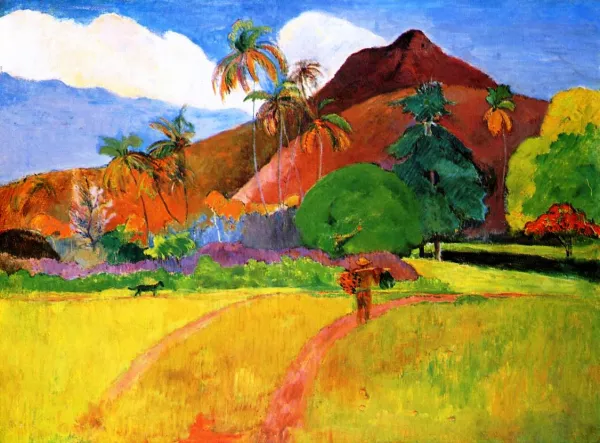 Dimensions: 12 1/8 x 18 1/4 inches (30.8 x 46.4 cm)
Dimensions: 12 1/8 x 18 1/4 inches (30.8 x 46.4 cm)Year: 1899
Current Location: The William S. Paley Collection at the Museum of Modern Art, New York
Tahitian Landscape
Gauguin's Tahitian Landscape offers a window into the world he discovered on the island. The painting showcases his bold, expressive style, with lush, tropical foliage and a warm, sun-drenched palette. Sinuous contours and intense colors blend harmoniously, conveying the joy and serenity Gauguin found in this idyllic setting.
This work is considered one of the first paintings Gauguin created after arriving in Tahiti in 1891, a time when he was seeking new artistic inspiration and a respite from the constraints of European civilization. Through his art, Gauguin aimed to suggest "a luxurious and untamed nature, a tropical sun that sets aglow everything around it...the equivalent of the grandeur, depth, and mystery of Tahiti." Tahitian Landscape stands as a testament to his success in capturing the essence of this remarkable place on canvas.
The painting's inclusion in the prestigious William S. Paley Collection at the Museum of Modern Art further underscores its significance as a seminal work in Gauguin's oeuvre and a touchstone of Post-Impressionist art. This painting invites viewers to immerse themselves in the beauty and tranquility of Gauguin's tropical paradise, offering a glimpse into the artist's creative vision and his enduring legacy.
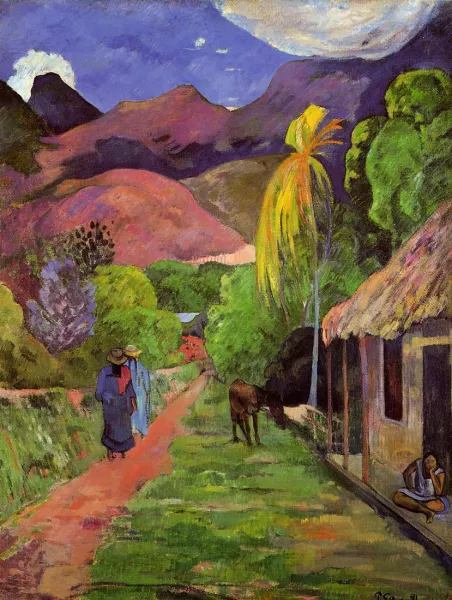 Year: 1891
Year: 1891Current Location: Minneapolis Institute of Arts
Road in Tahiti
Road in Tahiti offers a fascinating look into the world Gauguin encountered when he first arrived on the island in 1891. The painting presents a simple dirt path, little more than an open clearing, winding past a small hut and tall trees that provide a sense of balance and depth. Warm tones of red soil and bright yellows and oranges on the leaves create a sun-drenched atmosphere.
Several people are shown making their way along the road, while a donkey or horse rests by itself. In the distance, hills rise up to mountains, with a sliver of blue sky and white clouds above. This work provides a historical record of 19th-century Tahiti, while also showcasing Gauguin's unique artistic vision. His use of color and simplified forms hints at the joy and serenity he found in this new environment, a stark contrast to the constraints of European society he had left behind.
Road in Tahiti is considered one of Gauguin's earliest and most significant works from his time in Tahiti. It serves as a testament to his ability to capture the essence of life on the islands, offering a glimpse into the world that would inspire his most iconic paintings. The work's inclusion in the collection of the Minneapolis Institute of Arts underscores its importance as a key piece in Gauguin's artistic journey and a valuable record of a bygone era in Tahiti's history.
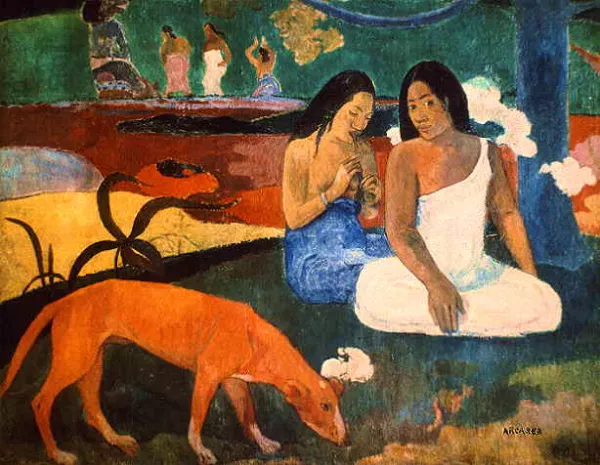 Dimensions: 75 cm × 94 cm (29.5 in × 37 in)
Dimensions: 75 cm × 94 cm (29.5 in × 37 in)Year: 1892
Current Location: Musée d'Orsay, Paris
Arearea Joyousness
Arearea, also known as Joyousness, is an expressive painting by Paul Gauguin. Created in 1892, this artwork radiates with energy and celebration, capturing the essence of joy and vitality. The painting features two Tahitian women in a lush tropical landscape, surrounded by vivid colors and symbolic imagery. Gauguin's use of color and form in Arearea evokes a sense of happiness and festivity, inviting viewers to immerse themselves in the world he portrays.
This masterpiece is housed in the Musée d'Orsay in Paris, where visitors can experience the beauty and dynamism of Gauguin's work up close. Arearea Joyousness is a testament to Gauguin's exploration of Tahitian culture and his ability to convey the spirit of joy through art. The painting remains a beloved and iconic piece in Gauguin's body of work, showcasing his unique artistic vision and his deep connection to the landscapes and people of Tahiti.
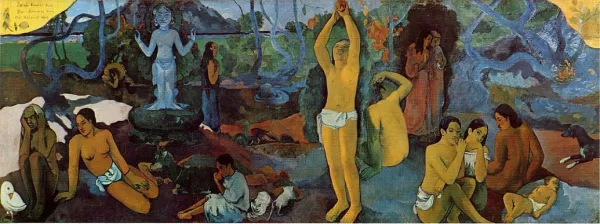 Dimensions: 139.1 × 374.6 cm (54.8 × 147.5 in)
Dimensions: 139.1 × 374.6 cm (54.8 × 147.5 in)Year: 1897-1898
Current Location: Museum of Fine Arts, Boston
Where Do We Come From? What Are We? Where Are We Going?
Where Do We Come From? What Are We? Where Are We Going? is a monumental painting by Paul Gauguin, created in 1897-1898. This work is considered one of Gauguin's most ambitious and complex, exploring themes of life, death, and the human condition. The painting features three Tahitian women in a contemplative scene, surrounded by lush foliage and symbolic imagery.
Gauguin's use of color and form in this painting is characterized by simplicity and grandeur, evoking a sense of introspection and contemplation. The work's title, which Gauguin himself described as "a philosophical and psychological question," invites viewers to ponder the mysteries of existence and the human experience. This painting is a testament to Gauguin's artistic genius and his ability to convey profound ideas through his art.